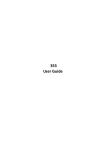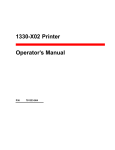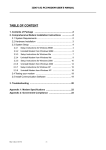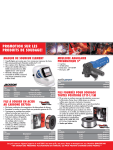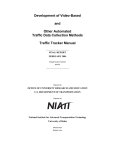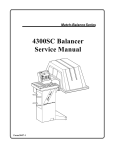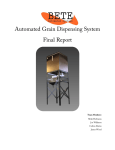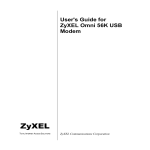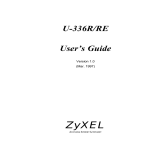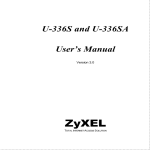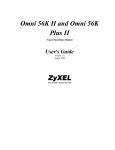Download Acer FAX/Voice/Data Modem User's Manual
Transcript
High Performance V.32bis/V.42bis 14,400 BPS Internal Plug and Play FAX/Voice/Data Modem Featuring Advanced FullDuplex Speakerphone Functions User's Manual Contents Section One Section Two Section Three Section Four Section Five Section Six Section Seven Section Eight Section Nine Introduction ........................... 1 Installation ............................. 1 AT Command Set .................. 4 S Register Summary ........... 12 Result Codes ......................... 13 Troubleshooting ................... 14 Specifications ....................... 16 Support And Service ........... 16 FCC, DOC, Copyright And Other Notices ....................... 17 Part #49.AA808.001 ACER 14.4 TAD-SP 1.xx Section One - Introduction This 14.4 Kbps FAX/Voice/Data Modem is specifically designed for the Acer Aspire line of computers, enabling their connection to all popular high speed modems available today. Your new modem features advanced speakerphone functions for hands-free voice communication as well as Plug and Play for simplified installation. This manual describes the hardware installation procedures for your new modem product. Additional information on AT commands and Sregisters are provided so that your system can be customized for a particular operating environment. Section Two - Installation This section will provide step by step instructions on how to install your new 14.4 Kbps FAX/Voice/Data modem. Installation of this modem product is a two-step process consisting of actual hardware installation and communication software installation and configuration. 2.1 Unpacking Your Modem Before you begin your installation, be certain that you have all the items listed below. This package contains: • A modem • A telephone cable • User's manual • Configuration software • Software for the modem • Software user's manual 2.2 Hardware Installation Installation of this modem requires opening and manipulating your PC. Exercise caution at all times when working with AC powered and static-sensitive equipment. Turn off and unplug your PC beFigure 2-1 fore installation. Discharge any Expansion static electricity from your body Slots by touching any bare metal surface of the PC system, such as its power supply cover. 1. 2. 3. Turn off and unplug your computer from the AC outlet. Remove your computer's cover (refer to your computer's owner manual). Select any available half-card 1 slot, and then remove the Figure 2-2 slot cover (refer to Figure 2-1). 4. Carefully slide the internal modem into the slot you have chosen, applying even pressure until the modem is completely seated in the slot. 5. Fasten the retaining bracket with the screw Mic/Speaker connector from the slot cover. Make sure the modem is properly aligned. Figure 2-3 Store the slot cover for future use. 6. Connect the computer sound card's microPHONE phone/speaker interconnector plug to the modem's mic/speaker connector (See figure 2-2). LINE 7. Replace the computer cover and plug in your computer. 8. Connect the telephone cable from the MIC modem's LINE connector (See figure 2-3) to the telephone wall jack. 9. Optionally connect your telephone to the modem's PHONE connector (See figure 2-3). 10. Connect the microphone plug into the MIC jack (See figure 2-3). 11. Connect your powered speaker(s) into the Line Out jack of the sound card. 12. Turn your computer on. Your modem is now installed. 2.3 Plug and Play Your modem supports Plug and Play (PnP) and can easily be configured using any Plug and Play compliant PC. Your PC is PnP compliant if you have: 1) an operating system that supports Plug and Play, and 2) PnP BIOS/chipset. In a PnP compliant operating system (e.g. Windows ® 95), follow the instructions included with the operating system to configure Plug and Play cards. On Acer pre-configured systems with this modem and Windows 95 software, this modem has been set to: 'MODEM' Sierra 14.4 Data Fax Voice SQ3230 2 COM 1, IRQ 4 'MODEM VOICE' Sierra 3230 (Voice) DMA 3, IRQ 10 2.4 Software Installation/Configuration You are now ready to install and configure the communication software. Refer to your software manual for installation procedures. Your software must be configured to communicate with the modem on the same COM port and IRQ line used by the modem. We suggest the following communication parameters when you first use your data communication software. Consult the software manual for information on using these and other parameters/features. 38,400 bps; 8 data bits; no parity; 1 stop bit; RTS/ CTS flow control set to “on;” initialization string: AT&F The commands used by the modem are compatible with the command set used by the “Hayes V-series Ultra Smartmodem 14400” modems, select this modem type in your data communications software. Select a “Generic Class 2” modem type in your FAX software and select a “Sierra” modem type in your voice software. 2.5 Using Fax, Voice, and Speakerphone Capabilities of the Modem Your modem has built-in advanced FAX, Voice, and Full Duplex Speakerphone functions. These functions are accessed through software. Please consult your FAX/Voice/ Speakerphone software manual about procedures on using these functions. Note that the modem's FAX/Voice/Speakerphone commands are used by the software to implement these functions and are not designed to be used as standalone AT commands. Voice functions include recording and playback of voice prompts (files). You may record or playback voice with your modem by attaching a telephone to the RJ-11 jack marked "PHONE" or by attaching a microphone to the MIC jack located on the back of the modem bracket. Then follow instructions in the FAX/Voice/Speakerphone software on recording and playback of voice prompts. 3 2.6 Testing Your Modem After Installation In order to test your modem you should be familiar with your communication software. Load and set up your communication software and enter into “terminal mode.” Make sure that the COM Port and IRQ settings of the software modem match the modem. Type AT on your terminal screen and press ENTER. You may see “AATT” or nothing on the screen. In either case, the modem should respond with an OK or 0. If it does not, please refer to Section 6 for troubleshooting information. 2.7 Using Your Modem The communication software included with your modem product provides a user friendly interface to access the fax, voice, and data functions of your modem. This software should be sufficient for all of your communication needs. There may be times when you need to access the modem manually via modem commands. Read Section 3 for a summary description of the modem command set before manually accessing the modem. You may want to read the software manual first, however, as the software may already provide a user friendly method of accessing the functions you need (i.e. dialing or answering calls). 2.8 Where To Go From Here You should familiarize yourself with the functions available from the included software by reading its manual. You will be accessing most, if not all, of the modem's functions from this software. You may also use any other commercially available communication software with the modem. Read Section 3 only if you are interested in accessing the modem manually, and not through the included software. Section 4 and 5 contain reference material, and can be skipped. If you have difficulties getting your modem to work, read Section 6, Troubleshooting, to find answers to commonly asked questions and problems. Section Three - AT Command Set 3.1 Executing Commands Commands are accepted by the modem while it is in Command Mode. Your modem is automatically in Com- 4 mand Mode until you dial a number and establish a connection. Commands may be sent to your modem from a PC running communication software or any other terminal devices. Your modem is capable of data communication at rates of: 300, 1200, 2400, 4800, 9600, 14400, 19200, 38400, and 57600 bps. Make sure your COM port baud rate setting in your communications software is set to one of the above speeds. 3.2 Command Structure All commands sent to the modem must begin with AT and end with ENTER. All commands may be typed in either upper or lower case, but not mixed. To make the command line more readable, spaces may be inserted between commands. If you omit a parameter from a command that requires one, it is just like specifying a parameter of 0. Example: ATH [ENTER] This command causes your modem to hang up. 3.3 Basic AT Commands In the following listings, all default settings are printed in bold text. Command Function A Manually answer incoming call A/ Repeat last command executed. Do not precede A/ with AT or follow with ENTER AT Appears at the beginning of every command line B_ B0 B1 B2 B3 D_ L CCITT mode Bell mode With V.23, originate calls transmitting at 75 bps, receiving at 1200 bps. Answer calls transmitting at 1200 bps, receiving at 75 bps. With V.23, originate calls transmitting at 1200 bps, receiving at 75 bps. Answer calls transmitting at 75 bps, receiving at 1200 bps 0 - 9, A-D, # and * last number redial 5 P T W , DS=n E_ pulse dialing touch-tone dialing wait for second dial tone pause @ wait for five seconds of silence ! flash ; return to Command Mode after dialing : return to Command Mode after dialing and maintain connection Dial one of the four telephone numbers (n=03) stored in the modem’s non-volatile memory E0 E1 +++ Commands are not echoed Commands are echoed TIES Escape Characters - Switch from Data Mode to Command Mode H_ H0 H1 Force modem on-hook (hang up) Force modem off-hook (make busy) I_ I0 I1 I2 I3 I4 I6 Display 14400 Display 000 Internal memory test Firmware revision number Configuration settings DSP L_ L0 L1 L2 L3 Low speaker volume Low speaker volume Medium speaker volume High speaker volume M_ M0 M1 M2 M3 Internal speaker off Internal speaker on until carrier detected Internal speaker always on Internal speaker on until carrier detected and off while dialing N_ N0 N1 Line speed set by register S37. Originate with automatic rate negotiation starting at S37 setting, answer at any speed. Adds V.23 to N1 Originating line speed set via register S37 Same as N3 Originate with automatic rate negotiation starting at S37 setting, Anwer only at S37 setting N2 N3 N4 N5 O_ O0 Return to Data Mode 6 O1 Return to Data Mode and initiate an equalizer retrain Q_ Q0 Q1 Q2 Modem sends responses Modem does not send responses Modem sends responses in originate mode but not in answer mode Sr? r=0-30 Read and display value in register r P Set Pulse dial as default Sr=n Set register r to value n (r=0-30; n=0-255) T Set Tone Dial as default V_ V0 V1 Numeric responses Word responses W W0 W1 Report Connect at DTE speed only. Report Connect at DTE speed with negotiation progress Report Connect at DCE speed only X_ X0 W2 X1 X2 X3 X4 Y_ Y0 Y1 Z_ Z0 Z1 Hayes Smartmodem 300 compatible responses/blind dialing Same as X0 plus all CONNECT responses/ blind dialing Same as X1 plus dial tone detection Same as X1 plus busy signal detection/blind dialing All responses and dial tone and busy signal detection Modem does not send or respond to break signals Modem sends break signal for four seconds before disconnecting Reset and retrieve active configuration profile 0 Reset and retrieve active configuration profile 1 3.4 Extended AT Commands &C_ &C0 &C1 Force Carrier Detect Signal High (ON) Turn on Carrier Detect signal when remote carrier signal is present &D_ &D0 Modem ignores the Data Terminal Ready signal 7 &D1 &D3 Modem returns to Command Mode after DTR toggle Modem hangs up, returns to the Command Mode after DTR toggle Resets modem after DTR toggle &F_ &F0 &F3 Recall factory default configuration Reset for extended responses &G_ &G0 &G1 &G2 Guard tone disabled 550 Hz guard tone 1800 Hz guard tone &K_ &K0 &K3 &K4 &K5 Disable DTE flow control RTS/CTS flow control XON/XOFF flow control Transparent XON/XOFF flow control &L_ &L0 &L1 Dialup telephone line Leased Line &M_ &M0 Asynchronous operation &N_ &N0 &D2 &N1 &P_ &P0 &P1 Special echo canceller training sequence not required Special echo canceller training sequence required United States setting for off-hook (make) to-on-hook (break) ratio UK and Hong Kong off-hook (make)-to-onhook (break) ratio &Q_ &Q0 &Q5 &Q6 Asynchronous operation Modem connects using MNP or V.42 Modem connects in Normal mode &S_ &S0 &S1 Force DSR Signal High (ON) DSR is off in command mode, on in on-line mode &T_ &T0 &T1 &T3 &T4 Ends test in progress Perform Local Analog Loopback Test Perform Local Digital Loopback Test Grant Remote Digital Loopback Test request by remote modem Deny Remote Digital Loopback Test request by remote modem Perform a Remote Digital Loopback Test Perform a Remote Digital Loopback Test and Self-Test &T5 &T6 &T7 8 &T8 Perform Local Analog Loopback Test and Self-Test &U_ &U0 &U1 Enable Trellis Coding @ V.32 Disable Trellis Coding @ V.32 &V_ &V0 &V1 Displays Active and Stored Profile 0 Displays Active and Stored Profile 1 &W_ &W0 Stores the active profile as Configuration Profile 0 &W1 Stores the active profile as Configuration Profile 1 &Y_ &Y0 &Y1 Configuration Profile 0 active upon Power on or reset Configuration Profile 1 active upon Power on or reset &Zn=x n=0-3 Store telephone number x into non-volatile RAM %E_ %E0 V.22bis auto-retrain disabled %E1 V.22bis auto-retrain enabled 3.5 MNP/V.42/V.42bis Commands %An n=0127 %C_ %C0 Disable MNP Class 5 data compression %C1 Enable MNP Class 5 data compression %D_ %D0 512 byte dictionary for V.42bis %D1 1Kbyte dictionary %D2 2 Kbyte dictionary \C_ \C0 \C1 \C2 Set auto-reliable fallback character to n (where n = 0 to 127,ASCII). Requires the \C2 setting Do not buffer data during LAPM/MNP handshaking Buffer all data for 4 seconds, until receiving 200 characters or until a packet is detected Do not buffer data; switch to normal mode when fallback character is detected \G_ \G0 \G1 Disable DCE flow control Enable DCE flow control \N_ \N0 \N1 \N2 \N3 \N4 \N5 Normal data-link only Direct data-link only MNP data link only MNP/Normal data link V.42 data link only V.42/Normal data link 9 \Q_ \N6 V.42/MNP/Normal data link \Q0 \Q1 \Q2 Turn off flow control XON/XOFF software flow control CTS signal unidirectional hardware flow control RTS/CTS signal bi-directional hardware flow control XON/XOFF unidirectionl flow control from modem \Q3 \Q4 \Tn Inactivity timer, where n = 0 to 90 minutes. Default is 0 \V_ \V0 \V1 Do not send extended responses Send extended response set 1 \X_ \X0 \X1 Process XON/XOFF but don’t pass through Process XON/XOFF and pass through #CC_ #CC0 Caller ID disabled #CC1 Formatted Caller ID (Date, Time Number) #CC2 Unformatted Caller ID 3.6 Fax Class 2 Commands +FAA=n Data/Fax auto answer enable. Default is 0 +FBOR Data Bit Order +FBUF=? Buffer Size +FBUG Session Message Reporting Parameter +FCIG Report Remote ID Response, CIG +FCFR Confirmation to Receive Prompt +FCLASS Service Class Identification and Control +FCON Facsimile Connection Response +FCR Capability to Receive +FCSI Report Remote ID Response Called Station +FCSIG=n Local Polling ID String +FDCS:<string> Report Session Response +FDCC=n DCE Fax Capabilities Parameters +FDIS:<string> Report Remote Capabilities Response +FDIS=n Current Session Negotiation +FDR Receive Phase C Data +FDT[=]n Transmit Phase C Data +FDTC: Report Remote Capabilities Response +FET: Post Page Message Response +FET=n End the Page or Document +FHNG Call Termination Status Response +FHR: Report Received HDLC Frame Response +FHT: Report Transmitted HDLC Frame 10 +FLID=n +FMDL? +FMFR? +FPPR: +FPTS: +FPTS: +FPTS=n +FREV? Local ID string (TSI/CSI) Request DCE Model Request DCE Manufacturer Partial Page Report Response Receive Page Transfer Status Response Transmit Page Transfer Status Response Page Transfer Status Parameter Request DCE Revision 3.7 Voice Mode Commands #VA=m #VAA=n #VB=f1,t #VBL=n #VBO=n #VBS=n #VC #VCH=n #VDR=e,r #VD0 #VD1 #VF=n #VG=n #VH=n #VL #VM=n #VNH=n #VRA=n #VRN=n #VSC=n #VSD=0,1,2 #VSI=n #VSM=n #VSn #VSP=n #VSR=n #VSS=n #VST #VSV #VTI=n #VTn Enable/disable AGC Select auto-answer mode Generate beep tone(f1=frequency,t=duration) Sets voice buffer length control Set binary offset mode Specify data transfer via DMA Disable, Enable <DLE><CAN> and DTMF abort Set DMA channel Enable distinctive ring detection Transmit voice data Receive Voice Data Set FIFO size Gain setting in voice record mode Energize relay Set run-length encoding Microphone command Set hook behavior for fax and data calls within voice calls Ringback goes away timer Ringback never came timer Set compression mode to n Silence deletion control (disable, 1 sec, .5 sec.) Set silence end of message timer Set CODEC mode to n Activate voice mode (DTE rate n) Set monitor mode Enable actions and/or speakerphone response codes Set sample rate to n Set silence threshold -43dBm/-47dBm Transmit voice data, listen for DTMF and CNG Supervision point qualifier Controls command mode DTMF and CNG detection 11 #VTR=n #VZ=n : Loop current interrupt qualifier Set audio mode Pager dial modifier 3.8 Speakerphone Commands #SPC=n #SPD=n #SPF=n #SPG=n #SPL=n #SPM=n #SPT=n #SPU=n #SPV=n #SPZ=n #VM=n Select AEC/EEC echo cancellation Download speakerphone parameters Select auto/fixed echo cancellation Set microphone gain Set DSP microphone gain Enable speakerphone Speakerphone forced train Upload speakerphone parameters Set speakerphone volume Set microphone AGC Set microphone status Section Four - S Registers Your modem has 39 registers, designated S0 through S27, S36-S38, S46, S48-S50, S63, S82, S86, and S98. Table 4-1 shows the registers, their functions, and their default values. Some registers can have their values changed by commands. If you use a command to change a register value, the command remains in effect until you turn off or reset your modem. Your modem then reverts to the operating characteristics specified in its non-volatile memory. Refer to Section 3 for information on how to use the AT commands to manipulate the S registers. Table 4-1 S - Registers Register S0 S1 S2 S3 S4 S5 S6 S7 S8 S9 S10 S11 S12 Function Range/units Default Auto-answer Ring Ring counter Escape code character Carriage return character Line feed character Backspace character Dial tone wait time Remote carrier wait time Comma pause time Carrier detect time Carrier loss time Touch-tone dialing speed Esc. character detect time 12 0-255/rings 0 0-255/rings 0 0-127/ASCII 43 0-127/ASCII 13 0-127/ASCII 10 0-32, 127/ASCII 8 0-255/seconds 2 1-255/seconds 40 0-255/seconds 2 0-255/0.1 second 6 0-255/0.1 second 14 50-255/0.001 second 75 0-255/0.02 second 40 S13 Reserved S14 Echo, response, dialing, Bit-mapped originate/answer S15 Reserved S16 Modem test options Bit-mapped S17 Reserved S18 Modem test timer 0-255/seconds S19 Reserved S20 Reserved S21 Auto retrain, RTS/CTS, Bit-mapped DTR, DCD, DSR S22 Speaker and response Bit-mapped S23 RDL, DTE data rate, Bit-mapped parity,and guard tone S24 Reserved S25 DTR delay 0-100/seconds S26 RTS/CTS delay interval 0-255/0.01 second S27 Async operation, Line Bit-mapped type S36 Negotiation Fallback 0-7 S37 Maximum line speed 0-11 S38 Forced hangup delay 0-255 S46 Select data compression 136, 138 S48 Feature negotiation 0, 7, 128 S49 Buffer lower limit 0-255 S50 Buffer upper limit 0-255 S63 Leased Line carrier level 0-15 S82 Break Signaling 3, 7, 128 S86 Connection failure code 0, 4, 9,10, 12-14 S98 Speakerphone squelch timer 0-255/.001second 0 5 1 7 0 20 138 7 10 200 0 128 10 Section Five - Result Codes BASIC RESPONSE CODES OK RING ERROR NO DIALTONE NO ANSWER CONNECT 4800 CONNECT 9600 CONNECT 14400 CONNECT 38400 CONNECT 1200/75 0 2 4 6 8 11 12 13 28 22 CONNECT NO CARRIER CONNECT 1200 BUSY CONNECT 2400 CONNECT 7200 CONNECT 12000 CONNECT 19200 CONNECT 57600 CONNECT 75/1200 EXTENDED RESPONSE CODES 13 1 3 5 7 10 24 25 14 29 23 CONNECT 0300/REL CONNECT 2400/REL CONNECT 9600/REL CONNECT 38400/REL 16 18 20 26 CONNECT 1200/REL CONNECT 4800/REL CONNECT 19200/REL CONNECT 57600/REL 17 19 21 27 NEGOTIATION PROGRESS CODES CARRIER 300 40 CARRIER 75/1200 45 CARRIER 2400 47 CARRIER 7200 49 CARRIER 12000 51 COMPRESSION: CLASS 5 COMPRESSION: V.42BIS COMPRESSION: NONE PROTOCOL: NONE PROTOCOL: LAP-M PROTOCOL: ALT CARRIER 1200/75 CARRIER 1200 CARRIER 4800 CARRIER 9600 CARRIER 14400 44 46 48 50 52 66 67 69 70 77 80 Section Six - Troubleshooting This section describes some of the common problems you may encounter while using your modem. If you can not resolve your difficulty after reading this chapter, contact your dealer or vendor for assistance. Modem does not respond to commands. 1. Make sure the communication software is configured to “talk” to the modem on the correct COM port and IRQ setting (same COM port and IRQ setting as the modem). Your communication software must know which address your modem is using in the system in order to pass data to it. Similarly, IRQ settings must be set correctly to receive data from the modem. 2. Make sure that your modem is initialized correctly. Your modem may have been initialized to not display responses. You may factory-reset the modem by issuing AT&F and press ENTER. The factory default allows the modem to display responses after a command has been executed. 3. Make sure the baud rate setting in your software is set to 57600, 38400, 19200, 14400, 9600, 2400, 1200, or 300 bps. An incorrect baud rate prevents the modem from operating properly. 4. Make sure that the modem is not conflicting with another COM port or IRQ in a non-PnP system. Modem does not dial. 14 1. Make sure the modem is connected to a working phone line. Replace the modem with a working phone to ensure that the phone line is working. 2. Make sure the phone line is connected to the jack marked “LINE.” Incorrect connection prevents the modem from operating properly. Refer to Section 2.2 for modem connection instructions. Modem dials but does not connect. 1. Make sure the IRQ setting is identical on both the modem and the software in a non-Pnp system. Modem and software must be configured identically. 2. Make sure the phone line is working properly. Replace the modem with a regular phone and dial the number. If the line sounds noisy, you may have difficulty connecting to the remote device. Modem makes a connection but no data appears on your screen. 1. The remote system may be waiting to receive your data before it begins. Try pressing the ENTER key a few times. 2. Make sure the correct data format (data bits, stop bits, and parity bits) and flow control (RTS/CTS) method are being used. 3. Make sure the correct terminal emulation mode is being used (see communication software manual). 4. Make sure the modem is not sharing an IRQ or COM port with another device in a non-PnP system. High pitch tone is heard whenever you answer the phone. 1. Make sure Auto-Answer is turned off. Your modem is factory configured to NOT auto-answer. Issue AT&F to factory reset your modem. Modem experiences errors while communicating with a remote modem. 1. Make sure the DTE speed is the same as the modem connection speed when in Direct Mode (\N1 command in effect). 2. Make sure the remote system and your modem use the same communication parameters (i.e., baud rate, data bit length, parity, and stop bit). 3. Make sure RTS/CTS hardware flow control is enabled and XON/XOFF software flow control is disabled in the communication software. 4. Make sure the data speed is not faster than your computer's 15 capability. Most IBM compatibles are capable of 19,200 bps under DOS and Windows. Operating at higher speeds under Windows requires a faster CPU (386/486 or better). Modem experiences bursts of errors or suddenly disconnects while communicating with a remote modem. 1. Make sure Call Waiting is turned off. 2. Make sure the phone line does not exhibit excess noise. Modem exhibits poor voice record or playback. 1. Make sure the correct modem type is selected in the Voice/ FAX software. Use “Sierra” or similar selection. Do not select “Rockwell or Rockwell ICS” configuration. Section Seven - Specifications CCITT/Bell Std. V.42bis, V.42, V.32bis, V.32, V.29, V.27ter, V.22bis, V.22, V.21, V.17, Bell212/103 MNP protocols: MNP 5, 4, 3, 2 Host Interface: 16-bit PC bus COM ports: 1, 2, 3, 4 IRQ lines: 3, 4, 5, 7, 9, 10, 11, 12 FAX Group: Group III Send/Receive Standard FAX Command set: EIA/TIA-PN2388 Service Class 2 Voice Command set: Sierra Escape Detection: TIES Escape Sequence Transmit level: -11 dBm +/- 1 dBm Receiver Sensitivity: -43 dBm UART: 16550 compatible Data format: 300-57600 bps Power: 0.75 W Temperature: 0 to 55 degrees C (Operating); -20 to 80 degrees C (Non-operating) Speakerphone: Full-duplex with DSP echo cancellation Plug and Play ISA spec. V1.0a Section Eight - Support and Service In the unlikely event you experience difficulty in the use of this product, we suggest you: (1) consult the Troubleshooting section of this guide and (2) consult with your dealer. To obtain service for this product, follow the Return Merchandise Authorization Procedure as outlined in the Warranty card. 16 Section Nine - FCC , DOC & Other Notices 9.1 FCC Compliance This equipment complies with Part 68 of the FCC Rules. On this equipment is a label that contains, among other information, the FCC registration number and Ringer Equivalence Number (REN) for this equipment. You must, upon request, provide this information to your telephone company. If your telephone equipment causes harm to the telephone network, the Telephone Company may discontinue your service temporarily. If possible, they will notify in advance. But, if advance notice isn’t practical, you will be notified as soon as possible. You will be informed of your right to file a complaint with the FCC. Your telephone company may make changes in its facilities, equipment, operations, or procedures that could affect proper operation of your equipment. If they do, you will be notified in advance to give you an opportunity to maintain uninterrupted telephone service. The FCC prohibits this equipment to be connected to party lines or coin-telephone service. In the event that this equipment should fail to operate properly, disconnect the equipment from the phone line to determine if it is causing the problem. If the problem is with the equipment, discontinue use and contact your dealer or vendor. The FCC also requires the transmitter of a FAX transmission be properly identified (per FCC Rules Part 68, Sec. 68.381 (c) (3)). 9.2 FCC Class B Statement This equipment has been tested and found to comply with the limits for a Class B digital device, pursuant to Part 15 of the FCC Rules. These limits are designed to provide reasonable protection against harmful interference in a residential installation. This equipment generates, uses and can radiate radio frequency energy, and if not installed and used in accordance with the instructions, may cause harmful interference to radio communications. However, there is no guarantee that interference will not occur in a particular installation. If this equipment does cause harmful interference to radio or television reception, which can be determined by turning the equipment off and on, the user is encouraged to try to correct the interference by one or more of the following measures: • Reorient or relocate the receiving antenna 17 • Increase the separation between the equipment and the receiver • Connect the equipment into an outlet on a circuit different from that to which the receiver is connected • Consult the dealer or an experienced radio / TV technician for help Notice: 1) Shielded cables, if any, must be used in order to comply with the emission limits. 2) Any change or modification not expressly approved by the Grantee of the equipment authorization could void the user’s authority to operate the equipment. 9.3 DOC Compliance Information NOTICE: The Canadian Department of Communications label identifies certified equipment. This certification means that the equipment meets certain telecommunications network protective, operational and safety requirements. The Department does not guarantee the equipment will operate to the user’s satisfaction. Before installing this equipment, users ensure that it is permissible to be connected to the facilities of the local telecommunications company. The equipment must also be installed using an acceptable method of connection. The customer should be aware that compliance with the above conditions may not prevent degradation of service in some situations. Repairs to certified equipment should be made by an authorized Canadian maintenance facility designated by the supplier. Any repairs or alterations made by the user to this equipment, or equipment malfunctions, may give the telecommunications company cause to request the user to disconnect the equipment. Users should ensure for their own protection that the electrical ground connections of the power utility, telephone lines and internal metallic water pipe system, if present, are connected together. This precaution may be particularly important in rural areas. Caution: Users should not attempt to make such connections themselves, but should contact the appropriate electric inspection authority, or electrician, as appropriate. NOTICE: The Load Number (LN) assigned to each terminal device denotes the percentage of the total load to be connected to a telephone loop which is used by the device, to prevent overloading. The termination on a loop may consist of any combination of devices subject only to the requirement that the sum of the Load Numbers of all the devices does not exceed 100. 9.4 Disclaimer, Copyright, And Other Notices 18 The information contained in this manual has been validated at the time of this manual's production. The manufacturer reserves the right to make any changes and improvements in the product described in this manual at any time and without notice. Consequently the manufacturer assumes no liability for damages incurred directly or indirectly from errors, omissions or discrepancies between the product and the manual. All registered trademarks are the property of their respective owners. Copyright © 1995 All rights reserved. No reproduction of this document in any form is permitted without prior written authorization from the manufacturer. First Edition -MAN030Rev 1.1 19 GZ/DR - Version 1.1




















